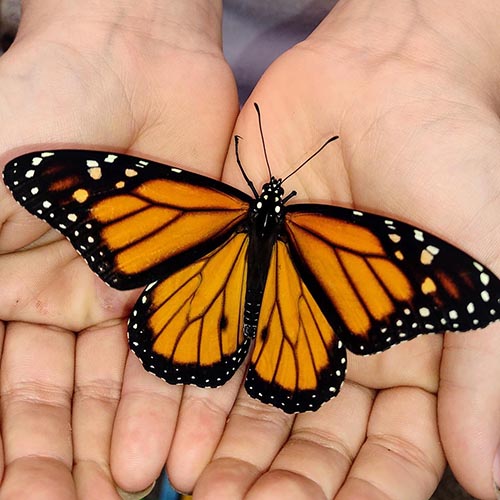
Listen to this Episode:
- From this webpage:
- Find the media player located under the episode picture.
- Click on the green triangle to listen to the audio for this episode.
- From your favorite podcast listening platform:
- Search for “Backyard Ecology.”
Show notes:
Monarch butterflies have become an increasingly hot topic in recent decades, and especially in the last couple of years. Conversations about monarchs often revolve around topics like their migrations, the importance of milkweeds, or other flowers we can plant for monarchs. Rarely do the topics of monarch health or monarch diseases come up. Yet these can also be fascinating and important topics to learn about and discuss.
In this episode of the Backyard Ecology podcast, we are joined by Dr. Sonia Altizer and Kade Donaldson. Sonia is a Professor of Ecology at the University of Georgia and Kade is the Project Manager for Monarch Health which is a community science project based out of the University of Georgia.
Most of our conversation revolves around the tiny protozoan, Ophryocystis elektroscirrha, more commonly referred to by its initials: OE. OE is a parasite of monarch butterflies that has been interacting with monarchs for the past several centuries, at least, and likely for almost as long as there have been monarchs. However, over the last couple of decades, something has changed.
OE has gone from being relatively rare to infecting very high percentages of some monarch populations. Exactly what has changed is still a topic of ongoing research, but the increased prevalence of OE appears to correlate to changes in human activities. The goal, therefore, is to determine what has changed and find ways to keep OE from spreading any more than it would naturally spread.
One of the ways that OE infections are being studied is through Project Monarch Health. Project Monarch Health is a community science project that asks members of the public to help document OE infections throughout the country. Anyone can participate in this project which is based out of the University of Georgia, and we talk about Project Monarch Health quite a bit during our conversation.
Other topics that we discussed are some of the common questions they get through Project Monarch Health. Those questions include ways people can help monarch butterflies and inquiries about raising monarchs. We also talked about how monarchs are only one part of the larger ecosystem. Protecting and conserving monarchs can also help lots of other organisms, but we need to be careful not to get so focused on monarchs that we lose sight of the big picture.
Links:
- Project Monarch Health:
- Email: monarchhealth@gmail.com
- Website: https://www.monarchparasites.org
- Facebook: https://www.facebook.com/ProjectMonarchHealth
- Instagram: https://www.instagram.com/projectmonarchhealth/?hl=en
- Other monarch-related Backyard Ecology content:
- Monarch vs Viceroy – Easy Identification Sitting or Flying: https://www.youtube.com/watch?v=zL5RJokLhp4
- Everything You Need to Know about the IUCN Listing of the Monarch Butterfly: https://www.backyardecology.net/everything-you-need-to-know-about-the-iucn-listing-of-the-monarch-butterfly/
- Diversity Matters When Gardening for Monarchs: https://www.backyardecology.net/diversity-matters-when-gardening-for-monarchs/
- Plant Multiple Species of Native Milkweeds for Monarch Caterpillars: https://www.backyardecology.net/plant-multiple-species-of-native-milkweeds-for-monarch-caterpillars/
- What does the endangered species ruling for the monarch butterfly really mean?: https://www.backyardecology.net/what-does-the-endangered-species-ruling-for-the-monarch-butterfly-really-mean/
- Milkweeds in Urban and Suburban Monarch Waystations with Dr. Adam Baker: https://www.backyardecology.net/milkweeds-in-urban-and-suburban-monarch-waystations-with-dr-adam-baker/
- Plant Taller Milkweed Species for Monarchs: https://www.backyardecology.net/plant-taller-milkweed-species-for-monarchs/
- Backyard Ecology:
- Website: https://backyardecology.net
- YouTube Channel: https://www.youtube.com/backyardecology
- Blog: https://www.backyardecology.net/blog/
- Patreon page: https://www.patreon.com/backyardecology
- Subscribe to Backyard Ecology emails: https://www.backyardecology.net/subscribe/
Episode image
- Male monarch butterfly
- Photo credit: Sonia Altizer, all rights reserved

Backyard Ecology: Exploring Nature in Your Backyard
Nature isn’t just “out there.” It’s all around us, including right outside our doors. Hi, my name is Shannon Trimboli, and I am the host of Backyard Ecology. I live in southcentral Kentucky and am a wildlife biologist, educator, author, beekeeper, and owner of a nursery specializing in plants for pollinators and wildlife conservation. I invite you to join me as we ignite our curiosity and natural wonder, explore our yards and communities, and improve our local pollinator and wildlife habitat. Learn more or subscribe to my email list at www.backyardecology.net.

Leave a Reply